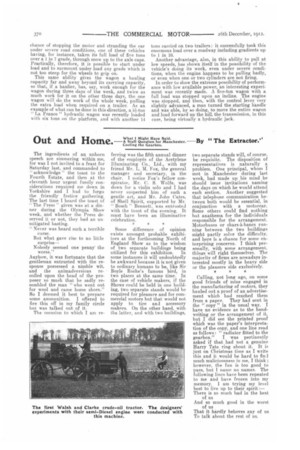The Gear Range of Hydraulic Transmission,
Page 13

Page 14

If you've noticed an error in this article please click here to report it so we can fix it.
By Henry Sturmey.
As readers of THE COMMERCIAL MOTOR may doubtless remember, matters are further advanced in regard to the employment of hydraulic transmission on motor vehicles in America than they are here, as, in the States, two makes of heavy commercial vehicles, employing the Manly system, have been on the market for over a year. Some interesting facts as regards their working are now available.
Of course, the great feature of a hydraulic transmission is its infinitely-variable gear ratios, and the most valuable point about this feature is to be found in that portion of the range between about zero and what would ordinarily be the first speed of a gearchange car. This secures two advantages. Chiefly, it avoids all shock in starting the load from rest., and so saves the chassis generally, not omitting the tires. In this respect, the contrast with the conventional system is very striking. With a five-ton wagon which has gear-wheel transmission, for example, the first speed would probably work out, at normal engine speed, at three-four miles per hour, and in order to start the car the engine is first speeded up to somewhere approaching its normal speed, and then the
clutch let in. If this were a positive clutch the effect would be that, the car and load—making a total of, probably, eight-nine tons—would have to be, at a bound, started into movement from zero at a rate of three-four miles per hour. [This is not found to
be so in practice. A good driver does not give an excessive amount of gas when starting in the lowest gear.—ED.]. The stress on every part of the transmission and on the engine would be enormous, and the probability is that, if it did not stop the engine, something would break. The employment of the slipping clutch saves the situation, and the sudden stress on the motor pulls the speed down and reduces the power. The elasticity of the power, therefore, together with the clutch, makes the present system possible. But, nevertheless, notwithstanding the combination, there is a very heavy and sudden stress sent through the chassis when the start is made, and, if this is great on the level, it is vastly greater when the wagon has been stopped on a really-steep incline and has to be started again. With a good hydraulic system, however, seeing that a slight touch on the control lever giving, say, 1-64th of an inch of eccentricity and a. corresponding stroke of the pumps, will result in giving an initial starting speed—with the full power of the engine available, if need be—of but a few score yards per hour, the starting effort may be quite small, and the vehicle will be brought up to its running speed in gradual easy stages, with no undue stress whatever anywhere.
This ability for working at very low speeds is also found enormously to increase the range of possible performance. Thus, for example, there will be less
chance of stopping the motor and stranding the ear under severe road conditions, one of these vehicles having, for instance, taken its full load of five tons over a 1 in 7 grade, through snow up to the axle caps. Practically, therefore, it is possible to start under load and to surmount under load any grade which is not too steep for the wheels to grip on.
This same ability gives the wagon a hauling capacity far and away beyond its carrying capacity, so that, if a haulier, has, say, work enough for the wagon during three days of the week, and twice as much work for it on the other three days, the one wagon will do the work of the whole week, pulling the extra load when required on a trailer. As an example of what can be done in this direction, a 511-ton "La France " hydraulic wagon was recently loaded i ill six tons on the platform, and with another 14
tons carried on two trailers: it successfully took this enormous load over a roadway including gradients up to 1 in 10.
Another advantage, also, in this ability to pull at low speeds, has shown itself in the possibility of the vehicle's doing its work, even under severe conditions, when the engine happens to be pulling badly, or even when one or two cylinders are not firing.
In order to show the extreme possibility of performance with low available power, an interesting experiment was recently made. A five-ton wagon with a full load was stopped upon an incline. The engine was stopped, and then, with the control lever very slightly advanced, a man turned the starting handle and was able, by so doing, to move the entire wagon and load forward up the hill, the transmission, in this case, being virtually a hydraulic jack.




















